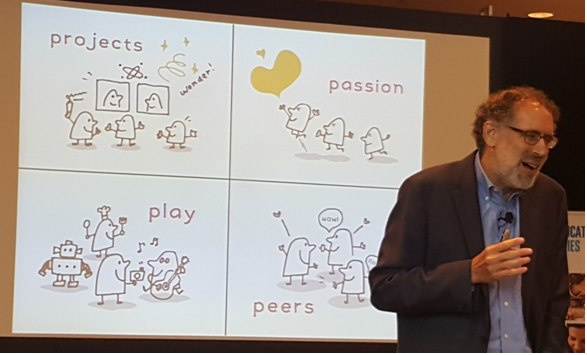Mitchel Resnick: The Four P's of Creative Learning

Projects.
People learn best when they are actively working on meaningful projects – generating new ideas, designing prototypes, refining iteratively.
As young people create Scratch projects, they engage in the “creative learning spiral”: they imagine what they want to do, create a project based on their ideas, play with their creations, share their ideas and creations with others, reflect on their experiences – all of which leads them to imagine new ideas and new projects. As students go through this process, over and over, they learn to develop their own ideas, try them out, test the boundaries, experiment with alternatives, get input from others, and generate new ideas based on their experiences. In the process, they develop as creative thinkers.
Peers.
Learning flourishes as a social activity, with people sharing ideas, collaborating on projects, and building on one another’s work.
We believed, from the beginning, that interaction with peers should be a central element in the learning process.
When we launched Scratch 10 years ago, we launched the online community, together and integrated with the programming language. And that was important to us. We wanted from the beginning for kids to be able to have an audience for what they created. It is also a source of inspiration.
The Scratch online community serves two roles. It provides an audience: when young people share their projects, they get feedback and suggestions from peers in the community. At the same time, the community provides inspiration: when young people try out projects made by their peers, they can get new ideas (and even borrow scripts and images) for their own projects. We designed Scratch so that it would be easy for people to remix one another’s projects. All projects in the Scratch community are covered by a Creative Commons license, so that people are free to build on one another’s work and ideas, as long as they give appropriate credit. More than a quarter of the projects on the Scratch website are remixes of other projects. The website provides visualizations to show how ideas spread among peers in the community.
Passion.
When people work on projects they care about, they work longer and harder, persist in the face of challenges, and learn more in the process.
That is why we are so happy about the diversity of the projects on the website. It is an indication that young people are working on Scratch projects that they really care about. This diversity of projects is a reflection of the diversity of interests of young people. With Scratch, young people from many different backgrounds, with many different interests, can all work on projects that they care about. And when people work on projects that they care about, they tend to work harder and learn more.
Play.
Learning involves playful experimentation – trying new things, tinkering with materials, testing boundaries, taking risks, iterating again and again.
When most people think about play, they think about fun and enjoyment. But when my research group thinks about play, we think about it somewhat differently. We think of play as an attitude and an approach for engaging with the world. We associate play with taking risks, trying new things, and testing boundaries. We see play as a process of tinkering, experimenting, and exploring. These aspects of play are central to the creative learning process. In designing Scratch, we wanted to encourage young people to tinker, experiment, and play with their projects. We designed the Scratch programming blocks to be “tinkerable.” You can continually experiment and iterate your programming scripts.

